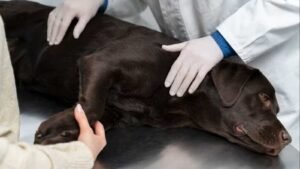It is caused by food particles and bacteria collecting along the gumline to form plaque. If plaque is not removed, minerals in the saliva combine with the plaque and form tartar (or calculus) which adheres strongly to the teeth. This is irritating to the gums and causes an inflammation called gingivitis, which can be seen as reddening of the gums adjacent to the teeth. It also causes bad breath.
If the calculus is not removed, it builds up under the gums and separates the gums from the teeth to form “pockets” encouraging more bacterial growth. At this point the damage is irreversible, and called “periodontal” disease. It can be very painful and can lead to loose teeth, abscesses, and bone loss or infection.
Signs and Symptoms
The following are signs that your dog may have a problem in his mouth or gastrointestinal system and should be checked by a veterinarian:
- Bad breath
- Excessive drooling
- Inflamed gums
- Tumors in the gums
- Cysts under the tongue
- Loose teeth
Gum disease is graded in terms of severity using the following scale:
| Grade 1 | Inflammation |
| Grade 2 | Inflammation, edema, gingival bleeding upon probing |
| Grade 3 | Inflammation, edema, gingival bleeding upon probing, pustular discharge — slight to moderate bone loss |
| Grade 4 | Inflammation, edema, gingival bleeding upon probing, pustular discharge, mobility — severe bone loss |
Getting familiar with the possible mouth problems your dog may encounter will help you determine when it’s time to see a vet about treatment:
- Periodontal disease is a painful infection between the tooth and the gum that can result in tooth loss and spread infection to the rest of the body. Signs are loose teeth, bad breath, tooth pain, sneezing and nasal discharge.
- Gingivitis is an inflammation of the gums caused mainly by accumulation of plaque, tartar and disease-producing bacteria above and below the gum line. Signs include bleeding, red, swollen gums and bad breath. It is reversible with regular teeth cleanings.
- Halitosis—or bad breath—can be the first sign of a mouth problem and is caused by bacteria growing from food particles caught between the teeth or by gum infection. Regular tooth-brushings are a great solution.
- Swollen gums develop when tartar builds up and food gets stuck between the teeth. Regularly brushing your dog’s teeth at home and getting annual cleanings at the vet can prevent tartar and gingivitis.
- Proliferating gum disease occurs when the gum grows over the teeth and must be treated to avoid gum infection. An inherited condition common to boxers and bull terriers, it can be treated with antibiotics.
- Mouth tumors appear as lumps in the gums. Some are malignant and must be surgically removed.
- Salivary cysts look like large, fluid-filled blisters under the tongue, but can also develop near the corners of the jaw. They require drainage, and the damaged saliva gland must be removed.
- Canine distemper teeth can occur if a dog had distemper as a puppy. Adult teeth can appear looking eroded and can often decay. As damage is permanent, decayed teeth should be removed by a vet.
Many dogs show signs of gum disease by the time they’re four years old because they aren’t provided with proper mouth care—and bad breath is often the first sign of a problem. Give your dog regular home checks, supplemented with your pet’s oral examination by a vet and, regularly (ideally twice in a year) get her teeth cleaned by a vet and you’ll have a very contented pet with a dazzling smile.


